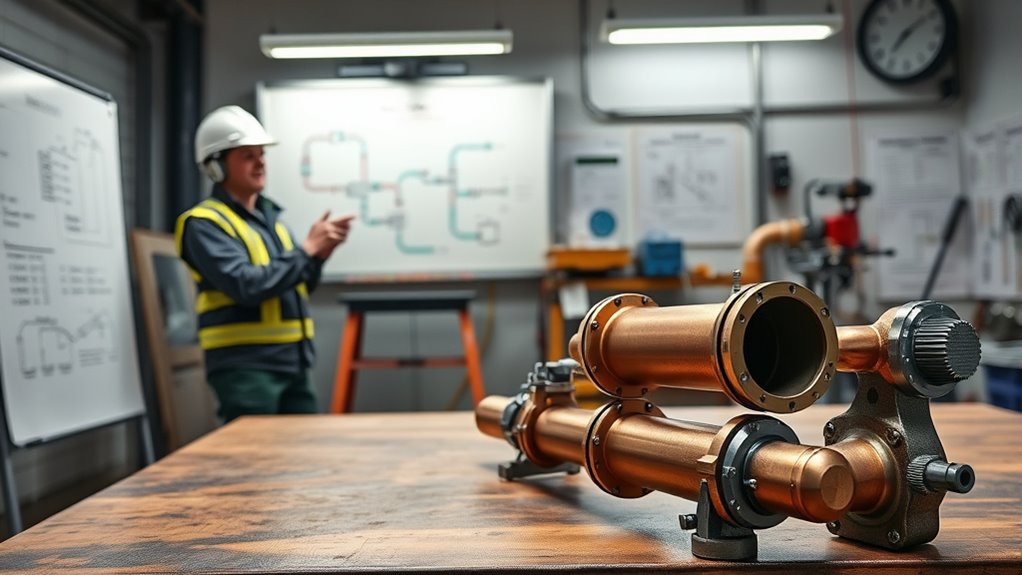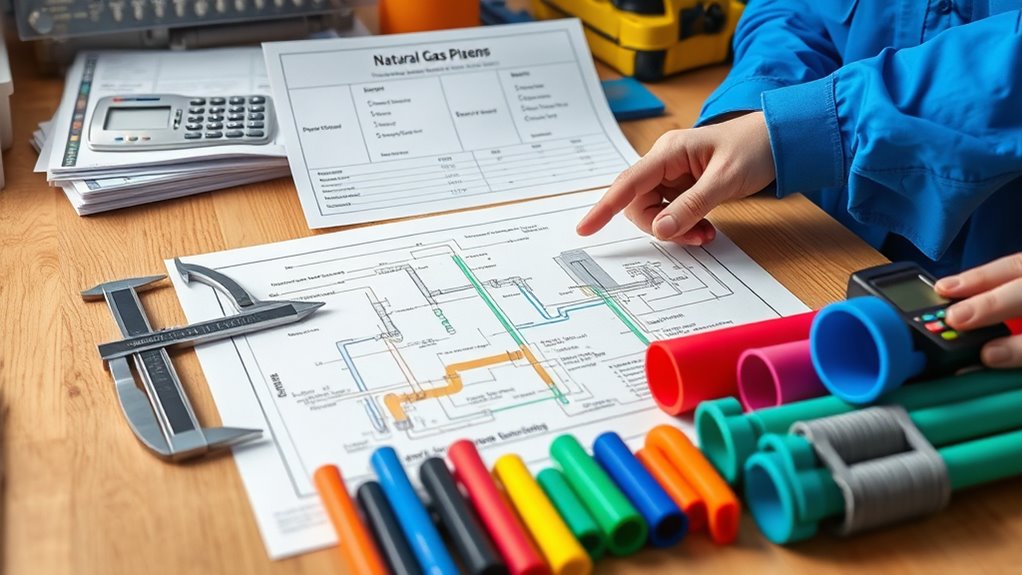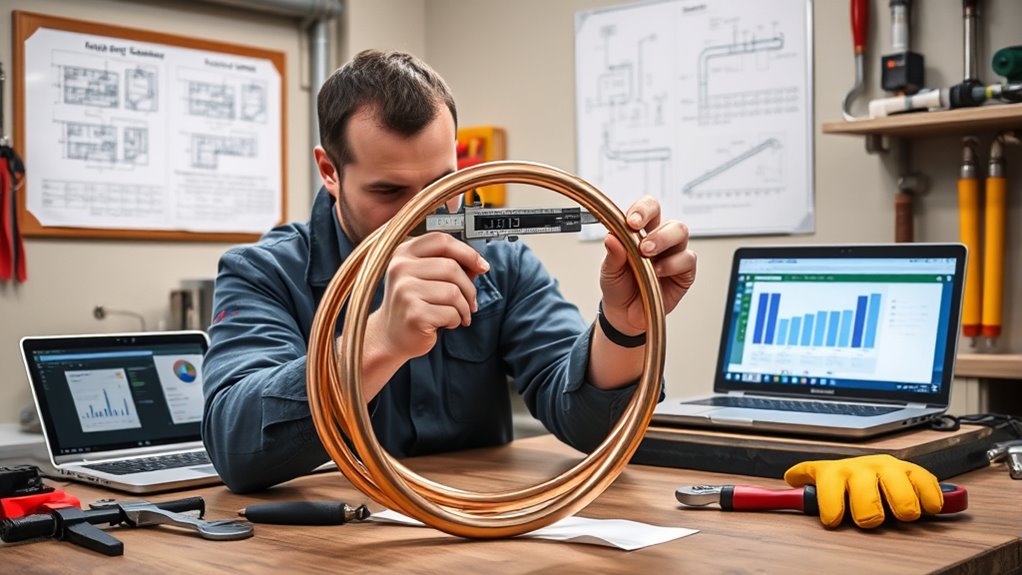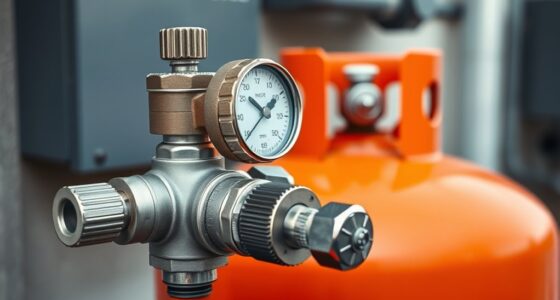To master natural gas line sizing in a weekend, focus on understanding key concepts like pressure and flow requirements, and learn to use essential tools like engineering calculators or industry charts. Follow a step-by-step process: determine inlet pressure, flow demand, and use formulas to find the right pipe diameter. Avoid common mistakes such as underestimating costs or ignoring safety standards. Keep safety and codes in mind—if you continue exploring, you’ll gain even more confidence in designing safe, efficient gas systems.
Key Takeaways
- Study fundamental principles of gas pressure, flow rates, and pipe materials to build a strong theoretical foundation.
- Use industry-standard calculators or software to practice sizing calculations with real-world examples.
- Learn to select appropriate pipe sizes by understanding flow capacities and applying pressure loss formulas like Darcy-Weisbach.
- Review local codes and safety standards to ensure your designs meet legal and safety requirements.
- Practice designing simple gas line systems, verify calculations, and consult resources to reinforce your understanding quickly.
Understanding the Basics of Natural Gas Line Sizing

Understanding the basics of natural gas line sizing is essential for ensuring safe and efficient gas delivery. You need to consider gas pressure, which affects how much volume flows through your pipes without overloading the system. Proper sizing prevents pressure drops that could compromise safety or appliance performance. Pipe materials also play a vital role; different materials like steel, copper, or flexible piping have unique characteristics influencing flow capacity and durability. When selecting pipe size, you must account for these factors to maintain consistent pressure and prevent leaks. Small pipes might restrict flow, while oversized pipes can be unnecessarily costly. By understanding how gas pressure interacts with pipe materials, you set a solid foundation for designing a reliable and safe natural gas line system.
Essential Tools and Resources for Accurate Calculations

Accurate natural gas line sizing relies on the right combination of tools and resources that streamline calculations and guarantee safety. You’ll need reliable references to determine appropriate pipe material and understand installation techniques that affect flow capacity. Essential tools include engineering calculators or software tailored for gas line design, which help account for pressure drops and material-specific characteristics. Resources like industry standards and code manuals provide necessary guidelines on pipe material compatibility and installation techniques, ensuring safety and efficiency. Additionally, having access to detailed charts for pipe sizes and pressure ratings helps prevent errors. Properly leveraging these tools and resources guarantees your calculations are precise, reducing risks and optimizing the gas delivery system. Incorporating knowledge of emotional support can also assist in managing the stress and challenges that may come with complex project planning.
Step-by-Step Process for Determining Proper Pipe Diameter

Once you have the necessary tools and resources in hand, you can begin the process of determining the proper pipe diameter. Start by calculating the gas pressure at the inlet, considering any pressure drops along the line. Use the flow rate requirements to identify the necessary volume of gas moving through the pipe. Next, consult pipe materials charts to understand their flow capacities and friction factors. Apply the Darcy-Weisbach or Hazen-Williams equations to account for pressure losses and velocity limits, ensuring safety and efficiency. Adjust the pipe diameter until the calculated pressure loss and flow rate meet the system’s specifications. This step-by-step approach guarantees you select a pipe size that handles the demand without risking pressure drops or safety hazards. Additionally, reviewing flow capacity data can help optimize your sizing decisions for safety and performance.
Common Mistakes to Avoid When Planning Gas Line Systems

When planning your gas line system, it’s easy to make mistakes that can compromise safety and efficiency. Common pitfalls include underestimating costs, which leads to budget shortfalls, or choosing improper materials that don’t meet safety standards. You might also overlook proper pipe sizing, causing pressure drops or overpressure issues. Additionally, neglecting accurate cost estimation and material selection can result in delays or costly replacements later. To avoid these mistakes, ensure you thoroughly research material durability and compatibility. Double-check your cost estimates to include all components. Also, verify that your pipe sizing aligns with your gas demand to prevent system failures. Remember, precision in planning now saves time and resources down the line. Incorporating contrast ratio considerations into your design can greatly improve system performance and safety. Avoid these errors for a safe, reliable, and efficient gas line system.
Practical Tips for Ensuring Safety and Compliance

To guarantee safety and compliance in your gas line system, you need to follow established codes and standards meticulously. This includes adhering to local building codes and regulatory standards designed to ensure safe installation and operation. Regularly inspect your gas lines for signs of wear or leaks, which is vital for gas leak prevention. Use proper materials and fittings approved for natural gas, and confirm all connections are tight and secure. Hiring licensed professionals for installation and inspections helps meet regulatory standards and reduces risks. Keep documentation of inspections and maintenance for future reference and compliance checks. By prioritizing safety protocols and staying informed about regulations, you’ll minimize hazards and guarantee your system operates safely and efficiently. Additionally, understanding home essentials related to gas safety can help you better maintain your system and prevent potential hazards.
Frequently Asked Questions
How Do Local Codes Influence Natural Gas Line Sizing Decisions?
Local codes considerably influence your natural gas line sizing decisions by setting safety standards and minimum requirements you must follow. You need to ensure code compliance to avoid violations or hazards. These codes dictate pipe size, pressure, and installation methods, guiding you toward safe, efficient gas line design. Always check with your local authorities before starting, as adhering to these codes ensures your system operates safely and meets legal standards.
Can I Retrofit an Existing Gas Line for Increased Demand?
Think of your gas line like a well-worn path—sometimes it needs widening to handle more traffic. You can retrofit an existing gas line for increased demand, but you must consider gas pipe upgrades carefully. Retrofit considerations include checking for corrosion, ensuring proper pipe size, and adhering to local codes. Always consult a professional to assess if your current line can handle the extra load safely, avoiding future problems.
What Are Signs of Improper Gas Line Sizing After Installation?
You’ll notice signs of improper gas line sizing if you experience inconsistent gas pressure, frequent pilot light outages, or gas leaks during detection. These issues often stem from poor pressure regulation or undersized lines. Regular gas leak detection is vital, and if leaks or pressure problems occur, it’s essential to consult a professional to reassess and properly size your gas line, ensuring safety and reliable operation.
How Does Altitude Affect Natural Gas Line Calculations?
Did you know that at higher altitudes, natural gas pressure drops by about 1 inch of water per 1,000 feet? You need to contemplate altitude considerations to ensure proper gas flow. This means making pressure adjustments in your calculations to compensate for thinner air, preventing under- or over-sizing your gas line. Always account for elevation changes to maintain safe and efficient natural gas delivery.
What Maintenance Practices Ensure Long-Term Safety and Efficiency?
You should regularly perform inspection procedures to catch any leaks, corrosion, or damage early. Keep an eye out for corrosion prevention by applying protective coatings and using corrosion-resistant materials. Schedule routine checks, especially at joints and fittings, to ensure safety and efficiency over time. Promptly address any issues you find, and maintain proper documentation to track maintenance history, helping prevent costly failures and ensuring long-term safe operation.
Conclusion
Mastering natural gas line sizing in a weekend is achievable when you understand key principles, use the right tools, and follow proper steps. Remember, accurate calculations are vital—underestimating pipe size can lead to safety hazards, while overestimating can be costly. Trusting established engineering theories, like the Darcy-Weisbach equation, helps guarantee your system’s efficiency and safety. With careful planning and attention to detail, you’ll confidently design a reliable gas line that meets both performance and safety standards.









